Website owner: James Miller
Complex integration. Complex and real line integrals, Green’s theorem in the plane, Cauchy’s integral theorem, Morera’s theorem, indefinite integral, simply and multiply-connected regions, Jordan curve
An integral that is evaluated along a curve is called a line integral. Such integrals can be defined in terms of limits of sums as are the integrals of elementary calculus.
Def. Complex line integral. Let C be a rectifiable curve (i.e. a curve of finite length) joining points a and b in the complex plane and let f(z) be a complex-valued function of a complex variable z, continuous at all points on C. Subdivide C into n segments by means of points a = z0, z1, ... , zn = b selected arbitrarily along the curve. On each segment joining zk-1 to zk choose a point ξ k . Form the sum
![]()
Let Δ be the length of the longest chord Δzk. Let the number of subdivisions n approach infinity in such a way that the length of the longest chord approaches zero. The sum Sn will then approach a limit which does not depend on the mode of subdivision and is called the line integral of f(z) from a to b along the curve:
![]()
Theorem 1. If F is a function such that dF(z)/dz = f(z) at each point of C, then
![]()
Real line integrals. There are different types of real line integrals. The most common type is
![]()
where
![]() is a vector point function
is a vector point function

defined over some region R of the plane,
![]() is a position vector
is a position vector

to point P on a curve C within R, the product is the dot product and the integral is evaluated
along C.
![]() is given by
is given by

and
![]()
can be written as
![]()
The line integral from point A to point B on C
![]()
can be written equivalently as
![]()
where T is the unit tangent to the curve and s is arc length along C. If
![]() represents a force field,
the integral represents the amount of work done in moving an object along the curve from point
A to point B.
represents a force field,
the integral represents the amount of work done in moving an object along the curve from point
A to point B.
If arc AB over which the integral is to be evaluated is smooth and given by the parametric equations

where t1
![]() t
t
![]() t2 , the value of 3) is given by
t2 , the value of 3) is given by
![]()
Theorem 2. Consider the real line integral
![]()
If P(x, y)dx + Q(x, y)dy, or more concisely, Pdx + Qdy, is an exact differential i.e. if

there is a function Φ(x, y) such that dΦ = Pdx + Qdy and the line integral is equal to the change of Φ(x, y) along the curve from point A to point B. Moreover, if ∂P / ∂y = ∂Q /∂x everywhere in a simply connected region, the value of the line integral between two points of the region does not depend on the path of integration.
Connection between real and complex line integrals. Real and complex line integrals are connected by the following theorem.
Theorem 3. If f(z) = u(x, y) + i v(x, y) = u + iv, the complex integral 1) can be expressed in terms of real line integrals as
![]()
Because of this relationship 5) is sometimes taken as a definition of a complex line integral.
Note that if the Cauchy-Riemann equations
![]()
are satisfied, both integrands “u dx - v dy” and “v dx - u dy” in the right member of 5) are exact differentials.
Intuitive interpretation of complex integral. What kind of intuitive, physical interpretation can one give to the complex integral? From 5) and 3) we see that
![]()
where

T is the unit tangent to the curve and s is arc length along the curve. The real and imaginary parts of 6) can be viewed as representing work done in the two force fields F1 and F2.
Properties of line integrals
If f(z) and g(z) are integrable along curve C, then
![]()
![]()
![]()
![]()
![]()
where |f(z)|
![]() M ( i.e. M is an upper bound of |f(z)| on C) and L is the length of C.
M ( i.e. M is an upper bound of |f(z)| on C) and L is the length of C.

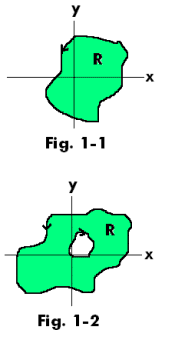
Def. Simply-connected region. A region R is said to be simply-connected if any simple closed curve which lies in R can be shrunk to a point without leaving R. A region R which is not simply-connected is said to be multiply-connected. The region shown in Fig. 1-1 is simply-connected. The regions shown in Figures 1-2 and 1-3 are multiply-connected.
Def. Jordan curve. Any continuous closed curve that does not intersect itself. Its length may be finite or infinite.
An intuitively obvious but very difficult to prove theorem follows:
Jordan Curve Theorem. A Jordan curve divides the plane into two regions having the curve as a common boundary.
The region that is bounded is called the interior and the other region is called the exterior.
Convention regarding traversal of a closed path. The boundary of a region is said to be traversed in the positive sense or direction if an observer traveling in this direction has the region to the left. Note the arrows in Figures 1-1, 1-2 and 1-3 and how those on the inner boundaries in the multiply-connected regions are pointed in the opposite direction from those on the outer boundary.
The notation
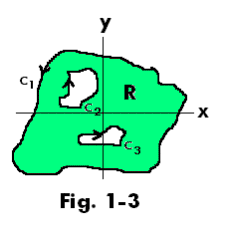
![]()
is used to denote integration of f(z) around the boundary C of a region in the positive sense. A full trip around the entire boundary is assumed. C denotes the aggregate of curves forming the boundary. In the multiply-connected region shown in Fig. 1-3 the boundary includes the entirety of curves c1, c2 and c3. This integral is called a contour integral.
Green’s Theorem in the plane. Let P(x, y) and Q(x, y) be continuous and have continuous partial derivatives in a closed region R, either simply or multiply-connected, and on its boundary C. Then

Complex form of Green’s Theorem. Let F(z,
![]() ) be continuous and have continuous
partial derivatives in a closed region R, either simply or multiply-connected, and on its boundary
C. Then
) be continuous and have continuous
partial derivatives in a closed region R, either simply or multiply-connected, and on its boundary
C. Then
![]()
where dA represents the element of area dxdy and z and
![]() are complex conjugate coordinates z =
x + iy and
are complex conjugate coordinates z =
x + iy and
![]() = x - iy.
= x - iy.
Cauchy’s integral theorem. Let a function f(z) be analytic within and on the boundary of a region R, either simply or multiply-connected, and let C be the entire boundary of R. Then
![]()
See Fig. 1-3 above.
Syn. Cauchy’s theorem, Cauchy-Goursat theorem
This theorem was first proved with the added condition that f '(z) be continuous in R and then Goursat gave a proof that removed this condition.
The following theorem is an immediate consequence of Cauchy’s integral theorem.
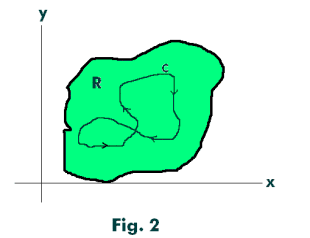
Theorem 4. Let a function f(z) be analytic in a simply-connected region R and let C be a closed (not necessarily simple) curve in R. Then
![]()
See Fig. 2.
Another immediate consequence of Cauchy’s integral theorem is the following theorem.
Theorem 5. If f(x) is analytic in and on the boundary of the region R between two simple closed curves C1 and C2 then
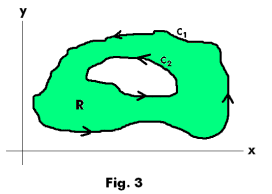
![]()
where C1 and C2 are both traversed in the positive sense relative to their interiors (counterclockwise). See Fig. 3.
Since there may be points in the interior of C2 where f(z) is not analytic, we cannot say that either of these integrals is zero. However, they do have the same value. Theorem 5 leads us to the extremely important principle of the deformation of contours:
Principle of the deformation of contours. The line integral of an analytic function around any closed curve C1 is equal to the line integral of the same function around any other closed curve C2 into which C1 can be continuously deformed without passing through a point where f(z) is nonanalytic.
Theorem 5 can be generalized in the following theorem.
Theorem 6. Let f(z) be analytic both in a region R bounded by the non-overlapping simple closed curves C, C1, C2, ..., Cn, where C1, C2, ..., Cn are inside curve C (see Fig. 4), and on the curves themselves. Then
![]()
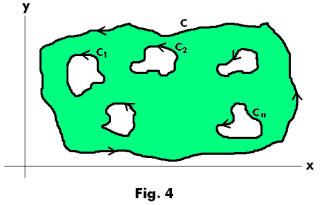
where C1, C2, ... , Cn are traversed in the positive sense relative to their interiors (counterclockwise).
Morera’s Theorem. Let f(z) be continuous in a simply-connected region R and suppose that
![]()
around every simple closed curve C in R. Then f(z) is analytic in R.
This theorem, often called the converse of Cauchy’s theorem, is also valid for multiply-connected regions.
Def. Indefinite integral. If f(z) and F(z) are analytic in a region R and such that dF(z)/dz = f(z), then F(z) is called an indefinite integral of f(z) and denoted by
![]()
Syn. Anti-derivative, primitive
Theorem 7. Let f(z) be analytic in a simply-connected region R. If a and b are any two points in R, then

is independent of the path in R joining a and b.
Theorem 8. Let f(z) be analytic in a simply-connected region R. If a and z are any two points in R and

then G(z) is analytic in R and G'(z) = f(z).
Theorem 9. Let f(z) be analytic in a simply-connected region R. If a and b are any two points in R and F'(z) = f(z), then
![]()
Example.
![]()
References
Mathematics, Its Content, Methods and Meaning
James and James. Mathematics Dictionary
Spiegel. Complex Variables (Schaum)
Wylie. Advanced Engineering Mathematics
Hauser. Complex Variables with Physical Applications.
Jesus Christ and His Teachings
Way of enlightenment, wisdom, and understanding
America, a corrupt, depraved, shameless country
On integrity and the lack of it
The test of a person's Christianity is what he is
Ninety five percent of the problems that most people have come from personal foolishness
Liberalism, socialism and the modern welfare state
The desire to harm, a motivation for conduct
On Self-sufficient Country Living, Homesteading
Topically Arranged Proverbs, Precepts, Quotations. Common Sayings. Poor Richard's Almanac.
Theory on the Formation of Character
People are like radio tuners --- they pick out and listen to one wavelength and ignore the rest
Cause of Character Traits --- According to Aristotle
We are what we eat --- living under the discipline of a diet
Avoiding problems and trouble in life
Role of habit in formation of character
Personal attributes of the true Christian
What determines a person's character?
Love of God and love of virtue are closely united
Intellectual disparities among people and the power in good habits
Tools of Satan. Tactics and Tricks used by the Devil.
The Natural Way -- The Unnatural Way
Wisdom, Reason and Virtue are closely related
Knowledge is one thing, wisdom is another
My views on Christianity in America
The most important thing in life is understanding
We are all examples --- for good or for bad
Television --- spiritual poison
The Prime Mover that decides "What We Are"
Where do our outlooks, attitudes and values come from?
Sin is serious business. The punishment for it is real. Hell is real.
Self-imposed discipline and regimentation
Achieving happiness in life --- a matter of the right strategies
Self-control, self-restraint, self-discipline basic to so much in life